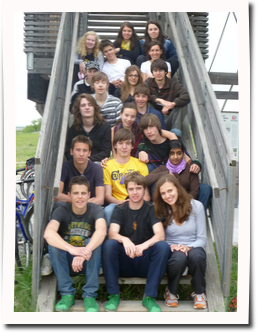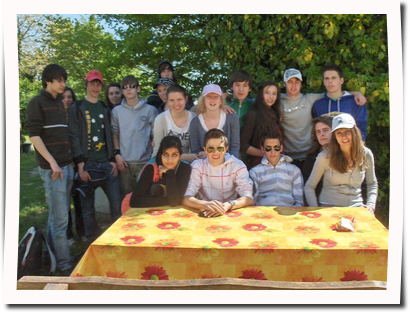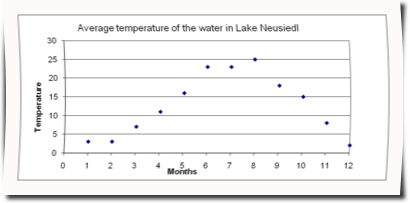
Alexander Klement
Donnerstag, 6. Mai 2010
|
|

|
Merler Sarah
Donnerstag, 6. Mai 2010
|
|
Our report is about the climate of the Neusiedlersee. You know, it is quite interesting how the weather changes.
The Burgenland and the whole Seewinkel area don’t belong to Austria from a climate point of view. This region is in the shadow of the Alps and has Pannonian climate charateristics.
It is amazing how many heat and dryness- loving animal and plant species can live there, because of the combination effect of light, rainfall, high temperatures, low humidity and continues wind.
One of the windiest regions of the European interior is the eastern shore of the Neusiedler See. The heat and the wind results a rapid evaporation in summer and autumn. The average temperature is 10°C.
Now some interesting facts about the seasons:
If you decide to visit this area in the spring, you should be prepared, because this is the windiest period of the year. It’s the most variable season and already in May temperature reaches 30° C. Because of the rainfall the water-level rises. It’s time for the nature to give life and there is a lot of natural phenomenon. Every day is a new day at Neusiedlersee and you can discover something new.
But if you are into hot and dry days, you should go there in the summer, when temperatures reach 30°C. It’s ideal for summer loving people. The sun can even dry-out waters, so that solid salt becomes visible.
Other facts about the summer:
- Hot and dry months
- 61 summer days
- Temperatures over 30°C
- Heat-waves
- Plants have a summer rest period
The autumn is perfect for nature watching. In this phase the vegetation begins a second growth. Many different kinds of plants and animals reawake after the dry summer months. This is because also in autumn temperatures reach about 20°C. The landscape is flowered like a colourful carpet.
Winter brings humid weather. Normally there is little snow and fog. The air temperature does not fall below the frost, but sometimes (at night) the temperature can sink under -15°C.
The lake freezes over for not more than 100 days, if at all.
The day time temperatures reach 17 °C, which is quiet abnormal, isn’t it?
Rainfall:
It is influenced weakly of Atlantic and Mediterranean currents and annual rainfall is reduced to less than 600 mm. There are two or three periods of relatively heavy precipitation.
Wind:
It is one of the windiest regions of Europe. Continues wind is useful for wind surfing and sailing. These winds can reach 6-10 on the Beaufort scale.
The wind can produce a tilting of the water surface.
|

Alexander Klement
Donnerstag, 6. Mai 2010
|
|

|
Reyer Beatrix
Mittwoch, 21. April 2010
|
|
Fauna and Flora
Great white egret (Silberreiher):
It is a large bird with white plumage which can reach one meter in height and weigh up to 950g. It has a yellow bill and black legs and feet; males and females are identical in appearance and juveniles look like non-breading adults.
The white egret is distributed across most of the tropical and warmer temperature region of the world - in southern Europe and Asia it is rather localized.
Two-thirds of the great white egrets breed at Lake Neusiedl on the “Große Schilfinsel”.
Grey egret (Graureiher):
It is also a large bird, standing 90-100 cm tall, nearly 2 meter wing span and a weight of 1-2 kg. Its plumage is grey and a bit white, it has a pinkish-yellow bill and its neck is retraced.
The grey egret inhabits Europe and almost the whole world. It is some cm bigger than the great white egret. At Lake Neusiedl it is very rare because there are no own breeding sites. In the winter it is located at the Danube. Also the grey egrets breed on the “Große Schilfinsel” and rear there their children.
Grey goose (Graugans):
It has a bulky body, a thick long neck and a large head. Moreover it has pink legs and feet and an orange or pink bill; they reach up to 90cm, the plumage is grey-brown.
We can find it in many European countries and they also breed at Lake Neusiedl. They eat grass, root, cereal leaves and spilled grain.
Common pheasant (Phasianus colchicus):
The common pheasant is native to Russia, but because of the Romans (they liked to eat them) we can find it all over Europe. The cock has a long brown streaked black tail, the body plumage is gold- brown with green, purple and white markings and he has a white neck ring. The female is smaller and has a mottled brown plumage. Pheasants live in grassland near water. Sometimes you can hear their famous calls “kok kok kok”, but you can’t see them in the air, because they prefer to run. They live on smaller animals, such as snakes or lizards and vegetable. It is a well-known gamebird and it is one of the world’s most hunted birds.
Seagull:
Appearance:
- plumage is usually grey or white, often with black markings on the head or wings
- range size goes from 120g and 29 cm to 1.75kg and 76 cm
- a very resourceful, inquisitive and intelligent bird (highly social structure and a complex method of communication for example mobbing behaviour if there are some other predators or intruders
- very long-lived birds because they can live up to a maximum of 49 years
Nutrition:
- carnivores: live food, in particular crabs and small fish, or scavenge opportunistically
Habitat:
- mainly on the coast but can also be seen on inland waters and refuse tips(especially outside the breading season)
- very gregarious----> they are breeding in large colonies on coastal cliffs, grass slopes, islands, and sand dunes
Egg-laying and hatching:
- generally laid in May - a clutch consisting of 2-4
- are incubated by both sexes for between 28-30 days
- young are fed by both parents, and fly when they are about 5-6 weeks old
European Hare:
Appearance
- is larger and has longer ears and has longer legs than a rabbit
- body size goes from 50-70cm
- full-grown adult ranges from 2.5 to 6.5kg
- run at speeds of up to 72km/h
Nutrition:
- herbivorous and therefore eats grasses and herbs during the summer months but changes feeding on twigs, bark, and the buds of young trees in winter.
Habitat:
- live in woods, velds and dunes, they like relative warm places. Today we can find European Hares obviously in Europe and Central Asia:
Propagation:
- in spring hares can be seen boxing, that is usually a female hitting a male, that shows that she´s not quite ready to mate or as a test of his determination.
European souslik (Spermophilus citellus):
The word souslik comes from Russian. The ground squirrel loves the sun, lives in prairies and steppes near lakes. Their size is more then 20cm and they have a yellow- grey furl and a white chin and throat. The tail is short and bushy. The European souslik feeds primarily on vegetation, nuts, seeds, and grains; but also birds' eggs. European sousliks mate only once a year, producing 2-9 youngs per birth. At lake Neusiedl sousliks can only live if the grass is short, so it’s very important that cows grass on the fields near the lake.
Salt flora
Plants typical of the sea coast grow in this type of soil (dried- out pool bottomsàsodium carbonate, sodium sulphate, magnesium sulphate and sodium chloride). The well-known are salt cress and pannonian sea Aster.
Salt cress (Thellungiella halophila); native to China; short life cycle; produces copious seeds; can self-pollinate; can be genetically transformed in Aradopsis; can grow with extreme saline conditions (500 mM NaCl).
Pannonian sea Aster (Aster tripolium); native to northern Europe in salt marshes; short live cycle; produces seeds; purple florets; lanceolate leaves;
Shelf:
It´s a large perennial grass which is found in wetlands throughout temperate and tropical regions of the world. It occurs along the margins of lakes, fens, marshes, and streams from the Arctic to the tropic. It is a broad-leafed grass, about 1.5 to 5 m (5 to 16.5 feet) tall, with feathery flower clusters and stiff, smooth stems. It´s flowers duced in late summer in a dense, dark purple panicle, about 20–50 cm long. Later they appear greyer due to the growth of long, silky hairs.
|
Cuccarollo Ernest
Mittwoch, 21. April 2010
Zuletzt geändert:
Donnerstag, 6. Mai 2010
|
|
Internationally recognized criteria
A national park is an instrument used world-wide for the long-term preservation of unique natural areas and, with them, the animal and plants habitats they support. It is a protected area that is managed mainly for ecosystem protection and for recreational use.
A national park is a natural area of land and/or sea designed to:
- Protect the ecological integrity of one or more ecosystems for present and future generations;
- Exclude exploitation
- Provide a foundation for spiritual, scientific, educational, recreational and visitor opportunities
The National Park Lake Neusiedl
The National Park Lake Neusiedl–Seewinkel was founded in 1993. It is one of the most important and diversified avian reservations in Europe. In 2001 the Lake Neusiedl region was declared a UNESCO World Heritage System and joins another 850 cultural and natural monuments around the world. The Lake Neusiedl is a biological borderland. Where one can find flora and fauna from Alpine, Pannonian, Asian, Mediterranean and Nordic regions. There are marshland, dry glassland, oak forests, sand steppe, pasture land, meadows and salty areas next to each other and 300 species of different birds.
Extent and Position
The Natural Park Lake Neusiedl – Seewinkel, where about 100 km² belongs to Austria and the other 200km² belongs to Hungary, is one of the most fascinating natural habitats in Europe. The lake itself is situated on the lowest point of the Hungarian lowlands and does not have a runoff. It includes about an area of 320km², 180 of it as reed belt.
Land management
As in the majority of national parks in Europe, many features of cultivated areas also constitute some of the habitats that are particularly worthy of protection. Even on the watery expanses of the salt pools and in the distinctive salt soils, human beings have left behind their marks over time: the clearing of woods, progressive drainage, extensive use of the land through haymaking and, in particular, through pasturage.
Land management in the Conservation Zone of the National Park targets the preservation and improvement of biotope quality in cultivated areas. The most important instrument are:
- Haymaking
- Rees harvesting
- Pasturage of grey cattle, water buffaloes, Przewlski horses and white donkeys
- Pasturage of spotted cattle
- Cultivation of field with organic farming
- Damming of surface water
Visitor management
- All human use in the Nature Reserve Zone in prohibited. Access to meadowlands, salt pools and reed beds is prohibited.
- Special exceptions are not granted, neither for professional photographers nor for students or scientists.
- Visitor management has made access roads, which can be used as walking and bike paths.
- These access roads and agriculture tracks are closed for traffic.
- The Information Centre in Illmitz plays a major role in visitor preparation.
- There are viewing platforms located in many places next to the path.
- Informational displays offer details to the area.
Research
Cornerstones of research in the Nature Reserve Zones are long-term scientific research, monitoring and enough collection of evidence. The basis of management plans is created by findings of this research.Already in the past, in 1990, the main focus of the research was aimed toward management within a national park structure. It was coordinated by the “Arbeitsgemeinschaft Gesamtkonzept Neusiedler See” and funded from state and federal budgets.
Here are some of the research projects which have been completed or are still in process:
- Study of Neusiedler See fish biology and considerations on resource management
- Study of ecology, distribution and economic value of hunted game species in the “Seewinkel” area
- Effects of agriculture and tourism
- Conservation activities in the National Park: Pasturage and its alternatives
- Study of population ecology invertebrates and bird species in the reed belt
- Analysis of sandpiper data from the “Seewinkel” area
- The importance of the reed belt habitat for fish species of the “Neusiedler See”
|

Alexander Klement
Mittwoch, 21. April 2010
|
|
The Landscape:
Open oak forests were originally the dominant feature of the Seewinkel landscape, before inhabitancy by Neolithic peoples. Seewinkel’s landscape today is the result of human intervention over thousands of years:
- extensive clearing of the woodland
- Drainage
- mowing and grazing
After World War II, there were still large herds which were grazing on common pasturage. It’s this form of semi-extensive cattle farming, which has a long tradition: There were lots of domestic animals driven to the nearby pasturage and brought back in the evening. In drier seasons like spring, higher and drier parts of the land were used for grazing; as the water level declines, margins around the pools were also used. This regular use for grazing had a manifold effect on the vegetation- it was stimulating biodiversity and pushing back reed growth from pool shorelines and wet meadows…
Saltwater pools:
A very special feature about Lake Neusiedl is the saltwater pools. Those 45 are situated all over the lake region. In depth they vary between 60 cm depth and total dryness. It’s rainfall in autumn and winter to reborn them, while in summer they dry out totally. Some of them have been lost to human interference, while some of them silted in naturally.
We normally combine saltwater pools with big oceans, so what’s the matter with those tiny inland pools? Together with Hungary and Asia it’s the only place to provide us similar phenomena. Some of them form because of breeches in the embankment and in addition sediments are deposited, which leads to erosion and inland depression- the basis for pool formation. But some of them are even older than the lake; Ice age left its mark by creating basins in which the pools then formed.
The salt concentration level increases as the water level drops.
The salt which we can find most into the lake Neusiedl is sodium carbonate but there are also other types like sodium sulphate…. .
This is the reason why we can find plants which we normally can only see on the sea coast.
When the polls have a brown colour they are called, ”black water’’ pools, the colour comes from the earth on the ground. Not only the salt content, also the different temperatures between day and night make it hard to survive in the pools. Typically inhabitants of the salt pools are the pied avocet and the Kentish plover.
Spögler Maximillian, Tobias Dorfmann
|
claudia
Mittwoch, 21. April 2010
|
|
Nadia, Petra und Claudia
The White Stork (ciconia ciconia)
Description:
- Mass: 2,3-4,4 kg
- Length: 1m
- Wingspan: 60-150 cm
- Age: lifespan in the wild->25 years ; captive individuals->48 years
White Storks are tall birds with long red legs, long neck and a red bill. The males and the females are similar. Storks are mute, because they have no syrinx. They communicate through bill-clattering and movements.
Habitat:
They occur in most of the warmer regions of the world depending on the season. During winter they inhabit northern, western and south-eastern parts of Africa and Asia. In April they return back to Europe for summer time. Their long journey back to Africa begins in August. Storks live in large nests made of sticks, dry grass and other vegetation. Their nests are generally close to water areas and to human habitation.
Food Habits:
Most storks eat frogs, fish, insects, earthworms, scorpions, spiders, snakes, small mammals and eggs of ground-nesting birds. They reach their food while walking with their bill pointed towards the ground.
Behaviour:
They occur in loose groups. During the breeding season white storks nest in small groups, but their nests are not close enough to be able to hear or see other pairs. During migration and in their winter range they form large groups of hundreds or thousands. White storks place their nests in high places, protecting their young and eggs from most terrestrial predators. They also vigorously defend the young. They are active during the day. The white stork is almost silent except for the noisy mutual bill-clattering when adults meet at the nest. It’s always a very lovely and spectacular reunion.
Other comments:
The presence of stork nests is viewed as a sign of good luck; the stork is not persecuted and often builds nests close to human habitation. The arrival of a white stork was once thought to herald the arrival of a new baby. They are also the official birds of Lithuania and part of the symbol for the city of The Hague, Netherlands.
|

Alexander Klement
Mittwoch, 21. April 2010
|
|
Steppe Lake (General)
A steppe lake is a lake that is usually very plain. It has a variable water-level which depends on rainfall and dry periods.
Depth of Water
The lake Neusiedl has a medial depth of one Meter (three feet) and a maximal depth of 1.8 meter (six feet)
History
It was formed between 16.000 – 12.000 BC during an Ice Age. The last big dry period was from 500 BC until 200 AD. 1811 it was completely desiccated. The last time the water level was over 3 meter (10 feet) in places was in 1878. In the last century many canal and dikeconstructions were done.
Temperature

Inlet and Outlet
The most important inflow is rainfall. Other appreciable inlets could be the Wulka, which comes from Austrian direction and the Kroisbach which arrives from Hungary. There are also many submontane fonts.
One outlet is the “Einser Kanal” which was built in 1900. But the biggest outlet is evaporation, because the lake fills up a big area.
Expansion
The lake includes an area of 320 km², where the closest point is about 5 km and the widest about 15 km.
Different nations
The lake is the national border between Austria and Hungary. But the national park includes both sides. So the connection between the nations turns out satisfactory.
Water quality
The water is very muddy, because the wind spins up tiny segments of the ground that decline very slowly.
There could also be mentioned that there is salt in the lake. The saline magnitude is about 1/20 of the sea.
Ecosystem
The transitional zone has a big variety of habitats, and the richness of species is given in a high level.
Economical use
The most important economical use is Tourism. Also the reed can be used as insulation to gain colefactory.
Moritz Prinoth, Villscheider Christian, Klement Alexander
----------------------------------------------------------------------------------------------
Mfg Grüßen Ville, Moore, Kalle
Rechtscheibfehöer sind erwünscht und keines ungewollt... xD
|




















Kategorie:
lake Neusiedl